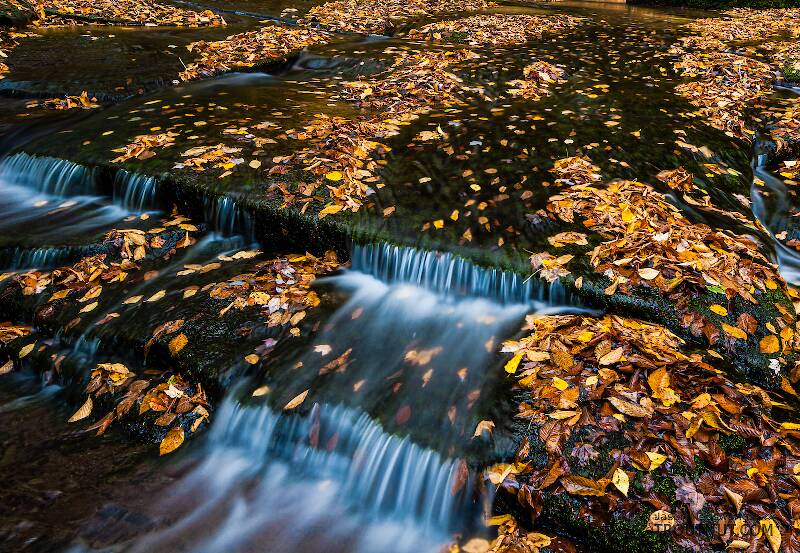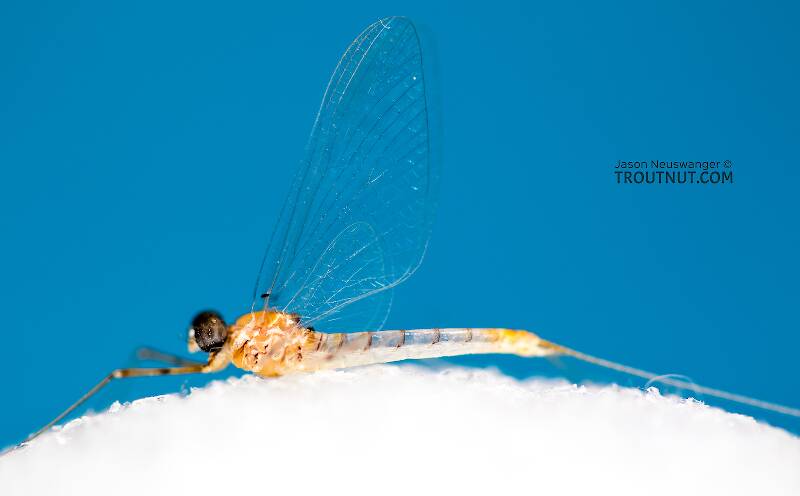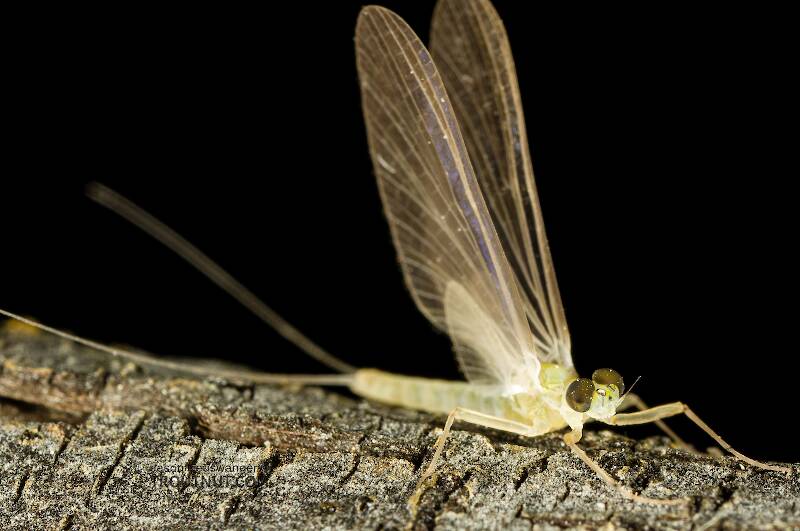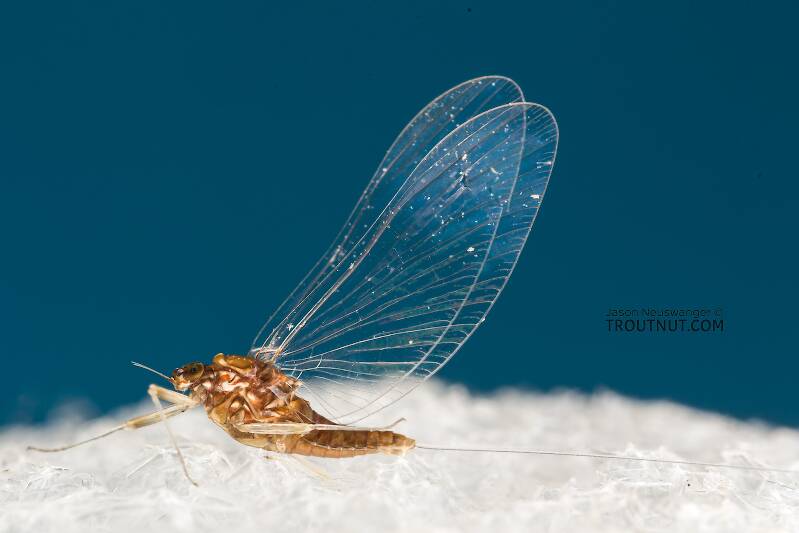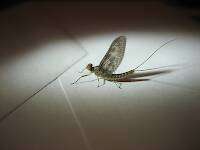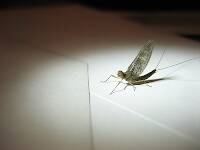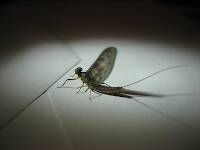
Hex Mayflies
Hexagenia limbata
The famous nocturnal Hex hatch of the Midwest (and a few other lucky locations) stirs to the surface mythically large brown trout that only touch streamers for the rest of the year.
Featured on the forum

Troutnut is a project started in 2003 by salmonid ecologist Jason "Troutnut" Neuswanger to help anglers and
fly tyers unabashedly embrace the entomological side of the sport. Learn more about Troutnut or
support the project for an enhanced experience here.
This topic is about the Insect Order Ephemeroptera
Mayflies may be the most important insects for trout anglers to understand. They are an ancient order of insects, famous outside the fly-fishing world for their fragile beauty and short adult lifespan, often a single day to mate and die. The mayfly's poignant drama attracts poets and anglers alike, but anglers make the most of it.Mayflies live more than 99% of their lives as nymphs on the river or lake bottom, filling many crucial roles in freshwater ecosystems as they feed and grow. They eventually emerge from the water as winged sub-adults called "subimagos" by scientists and "duns" by anglers. Duns evolved to be good at escaping the water, with a hydrophobic surface and hardy build, but they are clumsy fliers. Within a day or two they molt one last time into "imagos" or "spinners," the mature adults, a transformation captured in this photo series of a dun molting into a spinner. They have longer legs and tails, and sleeker, more lightweight bodies, giving them the airborne speed, agility, and long grasp they need for their midair mating rituals. They are usually darker than the duns and have shinier, more transparent wings. They die within minutes or hours after mating.
Example specimens
MarkA on Jul 7, 2008July 7th, 2008, 2:32 am EDT
The Rise: What can we learn?
I am new to trout fishing. The last two weeks I have been exposed to two different trout rises and takes. Neither time have I been able to observe what was on the water. Little brownish flys were in the air.
The first week I what I would describe as a ballistic rise (take). It was if rocks were being thrown in the water. Very large splashes and loud noise in the water were this rises trademark.
This week the rise was that of whale scooping up krill. The fish came to the surface with its mouth open, dorsal and tail fins above water. It would stay above water briefly and then quietly submerge. Again I did not see anything on the water but there was a cloud of flys above.
My buddy says it is different stages in the fly life cycle and I would agree, but what stages. Any help/comments are appreciated.
I am new to trout fishing. The last two weeks I have been exposed to two different trout rises and takes. Neither time have I been able to observe what was on the water. Little brownish flys were in the air.
The first week I what I would describe as a ballistic rise (take). It was if rocks were being thrown in the water. Very large splashes and loud noise in the water were this rises trademark.
This week the rise was that of whale scooping up krill. The fish came to the surface with its mouth open, dorsal and tail fins above water. It would stay above water briefly and then quietly submerge. Again I did not see anything on the water but there was a cloud of flys above.
My buddy says it is different stages in the fly life cycle and I would agree, but what stages. Any help/comments are appreciated.
Thanks and Gig'em
Chris_3g
Posts: 59
Posts: 59
Chris_3g on Jul 7, 2008July 7th, 2008, 3:38 am EDT
The first "ballistic" rise was likely the trout taking emergers. I'm not an entomologist, but I know that some insects (caddis, in particular?) develop a gas bubble prior to emergence which rockets them to the surface so they can emerge from the water very quickly. The trout respond in kind and rocket after these emergers, sometimes launching themselves out of the water. I have seen this, more often than not, with younger trout, but I'm sure this occurs with larger trout as well; larger trout tend to work a little more intelligently to avoid predation and whatnot.
Emerger patterns tend to include soft hackles with or without bead-heads, but there are a seemingly infinite number of options. I prefer the soft hackles: they are easy to tie, and they're popular for a reason.
The latter was likely a larger trout taking a bunch of midges. I don't know this with any certainty, but I have heard of very similar behaviors in the winter when midges are on the water. Either midge dry flies or emergers would probably work for this situation. Hope that helps.
Chris.
Emerger patterns tend to include soft hackles with or without bead-heads, but there are a seemingly infinite number of options. I prefer the soft hackles: they are easy to tie, and they're popular for a reason.
The latter was likely a larger trout taking a bunch of midges. I don't know this with any certainty, but I have heard of very similar behaviors in the winter when midges are on the water. Either midge dry flies or emergers would probably work for this situation. Hope that helps.
Chris.
Jjlyon01 on Jul 7, 2008July 7th, 2008, 1:29 pm EDT
Mark,
I am currently in Texas and I just got to take a short canoe trip down the Colorado River. I have not been able to fly fish for trout out in the hill country at all , but we were in Austin and I noticed large amounts of brown mayflies (I don't know proper names) that may be imitated by size 8 brown drakes. This is the only hatch that I have noticed that Texas has so far besides the cicada and mosquito. I have only fished for bass, gar, and channel cats so far and have done really well.
I am currently in Texas and I just got to take a short canoe trip down the Colorado River. I have not been able to fly fish for trout out in the hill country at all , but we were in Austin and I noticed large amounts of brown mayflies (I don't know proper names) that may be imitated by size 8 brown drakes. This is the only hatch that I have noticed that Texas has so far besides the cicada and mosquito. I have only fished for bass, gar, and channel cats so far and have done really well.
"I now walk into the wild"
Jmd123 on Jul 7, 2008July 7th, 2008, 7:23 pm EDT
Jjlyon01, check out the San Marcos River, about 1/2 hour south of Austin in San Marcos. Lots of bass plus HUGE sunfish (redbreast, redear, warmouth, spotted, and some rock bass too), and as a bonus a member of the cichlid family known locally as the "Rio Grand perch". Caddisflies hatch reliably in the evening after sundown (try size 12-14 elkhairs in white, light gray, light tan, and straw-colored, plus some with bright floss bodies [chartreuse, hot pink, orange, etc.], which I called "candy-caddis"), and Wulff patterns take big (8-10") surface-feeding redbreast sunfish as well. Woolly buggers and marabou muddlers, along with deer-hair poppers (try some tiny ones on size 10 dry fly hooks) and some various streamers (including Clousers) and nymphs, should also produce.
Most of the river through the city of San Marcos is a public greenway, so access should be easy.
Jonathon
Most of the river through the city of San Marcos is a public greenway, so access should be easy.
Jonathon
No matter how big the one you just caught is, there's always a bigger one out there somewhere...
Jjlyon01 on Jul 8, 2008July 8th, 2008, 12:41 pm EDT
I've been told that river is really neat unfortunately I have no wheels so getting off the refuge I'm interning at is hard. It is really awesome fishing here because no one is allowed to fish on refuge (shhh...) and I have caught a 9.4lb bass and many others, large gar, and some huge catfish all right in my backyard. I would really like to get out to the coast and hit the reds and specks but its not looking good.
"I now walk into the wild"
Quick Reply
Related Discussions
Topic
Replies
Last Reply
Re: Identification of a possible Cordulegaster Dragonfly Nymph
In Cordulegaster Dragonfly Nymph by IanB
In Cordulegaster Dragonfly Nymph by IanB
6
Feb 10, 2017
by Taxon
by Taxon

